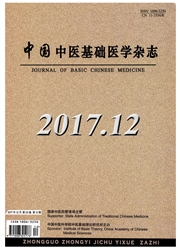

 中文摘要:
中文摘要:
目的动态观察清脑滴丸对急性脑缺血大鼠大脑皮层胶质原纤维酸性蛋白(GFAP)和神经元核抗原(Neu N)表达的影响,探究其对急性脑缺血的保护作用。方法将SD大鼠随机分为假手术组、模型组、清脑滴丸组3组,7个亚组,采用改良的Zea Longa法建立急性脑缺血动物模型,采用HE染色和尼氏染色观察脑组织形态学变化和损伤状况,采用免疫组化法检测GFAP、Neu N的表达水平。结果 HE染色和尼氏染色发现,大鼠在缺血再灌注的不同时点大脑皮层均出现了不同程度的病理形态学改变,以缺血再灌注24 h时较为显著,出现神经元水肿、细胞和血管间隙增宽、核固缩;免疫组化染色法发现再灌注3 h神经元和星形胶质细胞出现损伤,24~72 h神经元损伤较重,星形胶质细胞突起断裂明显,细胞排列稀疏;清脑滴丸组缺血1.5 h再灌注24 h和72 h神经元数量较模型组增多,细胞核着色较深。结论清脑滴丸可减轻急性脑缺血大鼠大脑皮层组织损伤,上调皮层Neu N和GFAP蛋白的过低表达,可减轻急性脑缺血损害。
 英文摘要:
英文摘要:
Objective To observe the effects of Qingnaodi Pill on the expression of glial fibrillary acidic protein (GFAP) and neuronal nuclear antigen (NeuN) in cerebral cortex in rats with acute cerebral ischemia, so as to explore its protective effect on the acute cerebral ischemia. Methods SD rats were randomly divided into a sham operation group, a model group and a Qingnaodi Pill group. The model of acute cerebral ischemia was established by the improved Zea Imnga method. HE staining and Nissl staining were used to observe the morphological changes and injuries of brain tissue; immunohistochemistry method was used to test the expression of GFAP and NeuN. Results According to HE staining and Nissl staining, the rats had various pathomorphologieal changes at different time points of ischemia reperfusion, especially 24 h after reperfusion which presented neuron edema, widened distance between cells and blood vessels and nuclear condensation. According to immunohistochemistry, there was injury on neuron astrocyte 3 h after reperfusion; the injury was more severe 24 h to 72 h after reperfusion, showing obvious astrocyte protuberance fracture, sparse cells. Compared with model group, the number of neurons in Qingnaodi Pill group was higher 1. 5 h after ischemia and 24 h to 72 h after reperfusion. Conclusion Qingnaodi Pill can reduce the cortical injuries in rats with acute cerebral isehemia. It can up-regulate the low expression of NeuN and GFAP protein in the cortex, thereby decreasing acute cerebral ischemia damage.
 同期刊论文项目
同期刊论文项目
 同项目期刊论文
同项目期刊论文
 期刊信息
期刊信息
